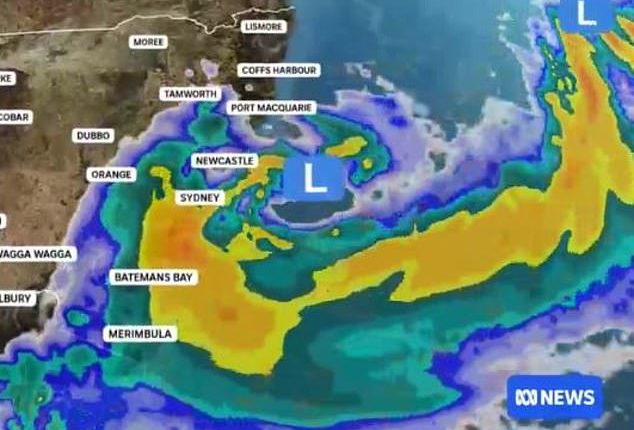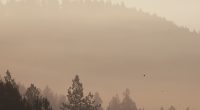Millions of Australians are in the path of a ‘bomb cyclone’ which has formed off the New South Wales coast.
Severe weather warnings have been issued for NSW, eastern Victoria and southeast Queensland as the explosive ‘cyclone’ has been confirmed off the coast and heads inland.
On Tuesday morning, meteorologists warned the system had developed in the western Tasman Sea and would be ‘even more explosive than initially forecast’.
The vigorous coastal low pressure system is expected to deepen throughout the day with damaging winds reaching up to 125km/h, including in parts of Sydney’s east.
Heavy rain and damaging surf conditions, with waves exceeding five metres in the surf zone have also been forecast.
The State Emergency Service has about 400 personnel ready to be deployed.
What is a bomb cyclone?
A bomb cyclone is a term used by meteorologists for bombogenesis, which refers to a storm that occurs when atmospheric pressure suddenly drops below a certain point.
This creates a volatile, fast-flowing air mass which results in a rapidly developing storm.

A bomb cyclone is a fast-developing storm that occurs when atmospheric pressure suddenly drops below a certain point, creating a volatile air mass

Millions of Aussies are being warned to prepare for ‘bomb cyclone’ which is set to hit NSW on Monday night (pictured cars driving through floodwaters at Wollongong in May)
The pressure drop required for a bomb cyclone in the Tasman Sea, between Australia and New Zealand, is 18 hectopascals near Tasmania to 13 hectopascals near the Queensland-NSW border.
This weather event will see the air pressure plunge by 22 and 24 hectopascals each day, which will lead to heavy rains and high winds.
The low is on course for a 24-hour drop in pressure of around 25 hectopascals, more than reaching the threshold for a bomb cyclone of 15hPa.
When will the weather system hit the coast?
Bureau of Meteorology forecaster Angus Hines explained that the powerful weather system would batter parts of NSW and Victoria from the start of the week, with up to 200mm of rain expected.
Aussies should be prepared for Tuesday and Wednesday to be the two biggest days when it comes to rainfall and weather impacts.
‘Tuesday’s the day when it is really going to deteriorate, and it’s going to be very wet and very windy, so the rain will likely last through much of the day,’ he told Daily Mail Australia.
‘We will see the winds absolutely howling up that NSW coast.
‘We could certainly see those gusts upwards of 80, 90, even 100 kilometres per hour around parts of the Sydney Metro area on Tuesday – that’s definitely enough to cause a bit of damage, bring down some trees.

Bureau of Meteorology forecaster Angus Hines explained some parts of the east coast could be lashed with up to 200mm of rain in just 48 hours

The affects of this dramatic weather change will last through Thursday
‘We could be talking about power outages as well.’
Aussies can expect the affects of the bomb cyclone to last through Thursday.
Where will be most affected?
The most intense rainfalls are expected over the Central Coast, delivering up to 200mm of rain.
Affected areas will stretch from the far south of the Mid North Coast, through the Eastern Hunter, Sydney, the Illawarra, and the South Coast, continuing all the way into Victoria’s Gippsland.
‘100 to 200mm of rain possible through these areas over 48 hours, and I expect some locations will pick up even more than that,’ Mr Hines said.
A strong wind warning has been issued by the Bureau of Meteorology for the East Gippsland Coast in Victoria.
A severe weather warning has been issued in NSW for the Mid North Coast, Northern Tablelands and parts of Northern Rivers, Hunter, Metropolitan, Illawarra, South Coast and North West Slopes and Plains Forecast Districts.
Damaging, locally destructive winds are expected along with heavy rainfall.

Huge swells could hit the east coast with marine wind warnings in place for NSW, eastern Victoria and southeast Queensland
Flood watches are in place for Mid North Coast, Hunter, Hawkesbury-Nepean, Sydney Illawarra Coast and Snowy catchments.
A harzardous surf warning is also in place for the NSW Coast, along with a generalised warning for Lord Howe Island, which is expected to be smashed with five metre waves.
A marine wind warning is also in place for most of the Queensland coast.
What damage could be caused by the bomb cyclone?
Authorities have warned residents to expect a serious weather event.
‘We are prepared here at the State Emergency Service … but what we need is for you to be prepared,’ NSW SES deputy commissioner Debbie Platz said on Monday.
‘We have been monitoring this system since Thursday of last week and so our state emergency services, including our partner agency, are all very well prepared and planned for this event.
‘We have deployed high clearance vehicles, aerial assets and personnel into the areas which we think will be most impacted by this forecasted weather.’
Fallen trees and power lines are a particular hazard along with flash flooding.

Fallen trees and power lines are a particular danger (pictured Queensland earlier this year)
In a high wind weather system, NSW SES recommends securing loose outdoor furniture, bringing pets indoors, seeking shelter away from power lines and trees and low-lying areas, and only travelling if necessary.
The forecasts have those impacted by last month’s devastating floods along the mid-North coast and Hunter region of NSW nervous.
Dairy farmer Michael Jeffery, whose sodden farm lies on the banks of the Macleay River, near Kempsey, said the rain was bringing people’s minds back to May’s catastrophic flood event.
‘It’s been raining all day already and that’s really got everybody on edge,’ he said.
‘It causes a lot of concern, because your livelihood is at risk, all the infrastructure on your farm that’s already been damaged by a flood and you worry about all your cattle and their wellbeing.’
Will flights be impacted?
Flights are set to be disrupted over the coming days.
‘This is a very dynamic and fast-moving system, very different to the systems that we have seen in recent times,’ NSW SES Deputy Commissioner Debbie Platz warned.









